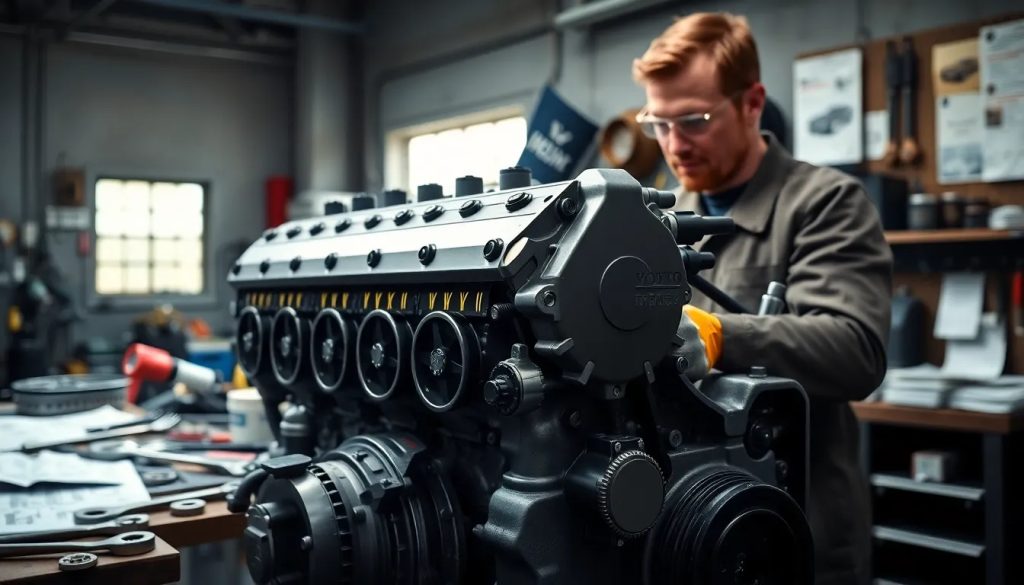Volvo D13 engine timing marks guide

Understanding the timing marks on your Volvo D13 engine is essential for maintaining optimal performance. These markings are crucial for ensuring the correct timing of engine components, which can significantly affect engine efficiency and longevity. In this guide, we will delve into the details of the Volvo D13 engine timing marks and provide you with a thorough understanding of how to manage them effectively.
The Volvo D13 engine is a robust engine widely used in heavy-duty trucks, and knowing how to read and utilize the timing marks can save you time and potential repair costs. In this article, we will cover everything from the necessary tools for replacing the timing gear cover to common mistakes to avoid during the process.
- Understanding the importance of Volvo D13 engine timing marks
- What tools are required for replacing the timing gear cover?
- How to safely remove the timing gear cover on a Volvo D13 engine?
- What are the step-by-step instructions for installing a new timing gear cover?
- How to ensure proper gasket placement and sealant application?
- What safety precautions should be taken during the replacement process?
- Common mistakes to avoid when working with Volvo D13 engine timing marks
- Related questions about Volvo D13 engine timing marks
Understanding the importance of Volvo D13 engine timing marks
The Volvo D13 engine timing marks play a pivotal role in the engine's overall functionality. These marks indicate the precise alignment of various engine components, ensuring that they work in harmony. Proper alignment is crucial for engine performance, as misalignment can result in severe damage.
Timing marks help in achieving the correct synchronization of parts such as the crankshaft and camshaft. When these components are not aligned correctly, it can cause issues such as poor engine performance, increased fuel consumption, and even engine failure. Therefore, understanding these timing marks is not just beneficial; it's essential for anyone working on a Volvo D13 engine.
What tools are required for replacing the timing gear cover?
Before you begin the replacement of the timing gear cover on a Volvo D13 engine, it's important to gather the necessary tools. Here are some essential tools you will need:
- Socket set
- Torque wrench
- Screwdrivers (flathead and Phillips)
- Gasket scraper
- Sealant applicator
- Crankshaft holding tool
Having the right tools at your disposal will make the job easier and help you avoid potential damage. The right socket sizes and a torque wrench will ensure that you can tighten bolts to the manufacturer's specifications, which is critical for a successful installation.
Additionally, a gasket scraper will assist in removing old gasket material without damaging the engine surfaces. Using a crankshaft holding tool may be necessary to prevent the crankshaft from rotating during the installation process, ensuring that you can maintain the correct alignment with the timing marks.
How to safely remove the timing gear cover on a Volvo D13 engine?
Removing the timing gear cover should be done with extreme care to avoid damage to the engine components. Follow these steps to safely remove the timing gear cover:
1. Disconnect the battery: Always start by disconnecting the battery to prevent any electrical issues.
2. Drain the coolant: Remove the coolant reservoir and drain the coolant to avoid spills.
3. Remove associated components: Take off any components obstructing access to the timing gear cover, including the fan and belts.
4. Unscrew the timing gear cover: Use the appropriate socket size to remove the screws holding the timing gear cover in place.
During this process, pay careful attention to keep everything organized. Label your parts and screws to ensure a smooth reassembly.
What are the step-by-step instructions for installing a new timing gear cover?
Installing a new timing gear cover on a Volvo D13 engine should be approached methodically. Here’s a step-by-step guide:
1. Clean the surface: Ensure that both the engine block and the new timing gear cover surfaces are clean and free of old gasket material.
2. Apply sealant: Use a suitable sealant on the engine block where the new cover will sit. This helps to create a watertight seal.
3. Align the timing marks: Before placing the cover, ensure that the timing marks on the crankshaft and camshaft are aligned correctly.
4. Install the new cover: Gently place the timing gear cover onto the engine block. Ensure that it fits snugly and aligns with the timing marks.
5. Torque the screws: Following the manufacturer's specifications, use a torque wrench to tighten the screws in a crisscross pattern to ensure even pressure.
By following these steps carefully, you can install the timing gear cover correctly and ensure proper function.
How to ensure proper gasket placement and sealant application?
Proper gasket placement and sealant application are vital for preventing leaks and ensuring a sealed environment in the engine. Here’s how to get it right:
- Select the right gasket: Always use a gasket that is specifically designed for the Volvo D13 engine. Using the wrong type can lead to leaks.
- Check for imperfections: Inspect the mating surfaces for any imperfections or damage that might prevent a proper seal.
- Apply sealant evenly: When applying sealant, use a consistent amount. Too much can squeeze out and contaminate the engine, while too little can lead to leaks.
Taking these steps will help you avoid common pitfalls during installation.
What safety precautions should be taken during the replacement process?
Safety should always be a priority when working on an engine. Here are some key precautions to consider:
1. Wear protective gear: Always wear gloves and safety goggles to protect against sharp edges and potential chemical exposure.
2. Work in a well-ventilated area: Ensure that your workspace is well-ventilated to avoid inhaling harmful fumes.
3. Follow manufacturer instructions: Adhere to any specific safety guidelines provided by the manufacturer in the service manual.
By prioritizing safety, you can protect yourself and ensure a successful engine repair.
Common mistakes to avoid when working with Volvo D13 engine timing marks
Misunderstanding or neglecting the timing marks can lead to serious issues. Here are some common mistakes to avoid:
- Ignoring the timing marks: Failing to verify the alignment of timing marks can lead to engine misfires or damage.
- Over-tightening bolts: Applying excessive force can damage components or cause them to warp.
- Neglecting gasket integrity: Using an old or damaged gasket can result in leaks, which could lead to engine failure.
Awareness of these common pitfalls can save time and resources during your repair.
How to identify timing marks?
To identify timing marks on a Volvo D13 engine, you can look for specific markings on the crankshaft and camshaft gears. These marks are typically indicated by notches or dots and are essential for ensuring the correct alignment of the engine components. Consult the service manual for precise locations and illustrations to aid in identification.
How to time an engine with timing marks?
Timing an engine using timing marks involves aligning the marks on the crankshaft and camshaft according to the specifications provided in the service manual. First, rotate the crankshaft until the timing mark aligns with the specified point. Then, adjust the camshaft as needed to ensure that both marks are aligned correctly. This process is vital to achieve optimal engine performance.
Will timing marks always line up?
Timing marks should line up correctly if the engine has been assembled or timed properly. However, factors such as wear and tear, improper installation, or incorrect servicing can cause misalignment. Regular checks and maintenance are essential to ensure that timing marks align as intended.
What are the timing marks in an engine?
Timing marks in an engine are indicators that help align critical components such as the crankshaft and camshaft. These marks ensure that the engine cycles in the correct sequence. Misalignment can lead to catastrophic engine failures, making it crucial to understand the significance of these markings.
 Volvo D13 engine vibration issues and solutions
Volvo D13 engine vibration issues and solutions Volvo D13 engine brake vibration issues
Volvo D13 engine brake vibration issues Volvo D13 engine oil leak: causes and solutions
Volvo D13 engine oil leak: causes and solutions Engine fuel delivery pressure Volvo D13 explained
Engine fuel delivery pressure Volvo D13 explainedIf you want to know other articles similar to Volvo D13 engine timing marks guide you can visit the category VOLVO.
Leave a Reply

RELATED POSTS